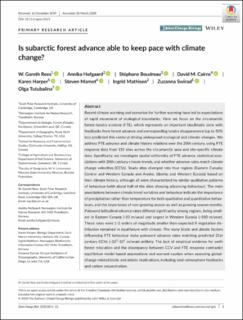| dc.contributor.author | Rees, W.Gareth | |
| dc.contributor.author | Hofgaard, Annika | |
| dc.contributor.author | Boudreau, Stephanie | |
| dc.contributor.author | Cairns, David | |
| dc.contributor.author | Harper, Karen | |
| dc.contributor.author | Mamet, Steven | |
| dc.contributor.author | Mathisen, Ingrid | |
| dc.contributor.author | Swirad, Zuzanna | |
| dc.contributor.author | Tutubalina, Olga | |
| dc.coverage.spatial | Eastern Canada, Central Canada, Western Canada, Alaska, Siberia, Western Eurasia | en_US |
| dc.date.accessioned | 2020-05-12T10:04:25Z | |
| dc.date.available | 2020-05-12T10:04:25Z | |
| dc.date.issued | 2020 | |
| dc.identifier.issn | 1354-1013 | |
| dc.identifier.uri | https://hdl.handle.net/11250/2654042 | |
| dc.description.abstract | Recent climate warming and scenarios for further warming have led to expectations of rapid movement of ecological boundaries. Here we focus on the circumarctic forest–tundra ecotone (FTE), which represents an important bioclimatic zone With feedbacks from forest advance and corresponding tundra disappearance (up to 50% loss predicted this century) driving widespread ecological and climatic changes. We address FTE advance and climate history relations over the 20th century, using FTE
response data from 151 sites across the circumarctic area and site-specific climate data. Specifically, we investigate spatial uniformity of FTE advance, statistical associations
with 20th century climate trends, and whether advance rates match climate
change velocities (CCVs). Study sites diverged into four regions (Eastern Canada; Central and Western Canada and Alaska; Siberia; and Western Eurasia) based on their climate history, although all were characterized by similar qualitative patterns of behaviour (with about half of the sites showing advancing behaviour). The main
associations between climate trend variables and behaviour indicate the importance of precipitation rather than temperature for both qualitative and quantitative behaviours, and the importance of non-growing season as well as growing season months.
Poleward latitudinal advance rates differed significantly among regions, being smallest in Eastern Canada (~10 m/year) and largest in Western Eurasia (~100 m/year). These rates were 1–2 orders of magnitude smaller than expected if vegetation distribution
remained in equilibrium with climate. The many biotic and abiotic factors
influencing FTE behaviour make poleward advance rates matching predicted 21st century CCVs (~103–104 m/year) unlikely. The lack of empirical evidence for swift
forest relocation and the discrepancy between CCV and FTE response contradict equilibrium model-based assumptions and warrant caution when assessing globalchange-related biotic and abiotic implications, including land–atmosphere feedbacks and carbon sequestration. | en_US |
| dc.language.iso | eng | en_US |
| dc.rights | Navngivelse 4.0 Internasjonal | * |
| dc.rights.uri | http://creativecommons.org/licenses/by/4.0/deed.no | * |
| dc.subject | circumpolar forest advance | en_US |
| dc.subject | climate change | en_US |
| dc.subject | climate change velocity | en_US |
| dc.subject | disappearing arctic tundra | en_US |
| dc.subject | forest migration rate | en_US |
| dc.subject | forest–tundra ecotone | en_US |
| dc.subject | range expansion | en_US |
| dc.subject | subarctic | en_US |
| dc.title | Is subarctic forest advance able to keep pace with climate change? | en_US |
| dc.type | Journal article | en_US |
| dc.description.version | publishedVersion | en_US |
| dc.rights.holder | © 2020 The Authors. | en_US |
| dc.subject.nsi | VDP::Matematikk og Naturvitenskap: 400::Zoologiske og botaniske fag: 480 | en_US |
| dc.source.journal | Global Change Biology | en_US |
| dc.identifier.doi | 10.1111/GCB.15113 | |
| dc.identifier.cristin | 1806629 | |

